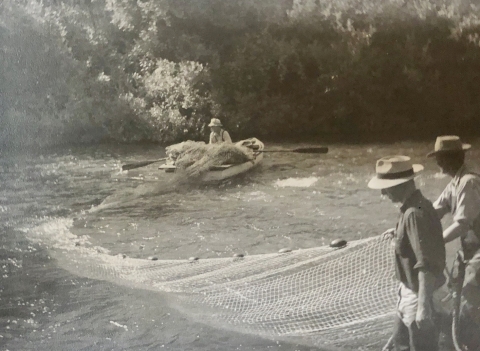Visit Us
The hatchery is open to the public daily (including holidays), 8:00 am to 4:00 pm. Adult Chinook salmon begin returning to Battle Creek in September and large numbers of salmon are gathered at the barrier weir by late-September and early-October. The best time for adult salmon viewing is typically the month of October.
We spawn fall Chinook salmon from early-October through mid-November and we spawn steelhead and late-fall Chinook salmon from January through mid-February. Spawning typically occurs on Tuesday and Thursday mornings, but you can contact the hatchery for information about spawning on a specific day.
Recreation and Education
The hatchery is open for self guided tours daily, 8:00 a.m. to 4:00 p.m.
Location and Contact Information
About Us
Coleman National Fish Hatchery is a complex consisting of both, the main hatchery, Coleman, and Livingston Stone National Fish Hatchery. Please visit the website for Livingston Stone NFH for more information.
Coleman National Fish Hatchery History
Fish have been produced in the northern Sacramento Valley for over 100 years. The first National Fish Hatchery, known as Baird Station, was established in 1872 on the McCloud River. The hatchery raised Chinook salmon and transferred eggs throughout the country, but most egg transfers were unsuccessful. The Baird Station is now located under Lake Shasta. Another facility, the Battle Creek National Fish Cultural Station, located near the mouth of the Sacramento River, was established in 1896.
The reproductively mature adults in a population that breed (or spawn) and produce more individuals (offspring or progeny).
Learn more about broodstock were collected from Battle Creek at the Battle Creek National Fish Culture Station. Circa 1896
The Coleman National Fish Hatchery was established in 1942 to mitigate for the loss of historic spawning areas. Contruction of Shasta and Keswick dams blocked access to approximately 187 miles of upstream habitat. Historically, Chinook salmon and steelhead trout migrated to the upper reaches of the Sacramento, Pit, and McCloud rivers to spawn.
Construction of the facility was authorized and established under the provisions of the Emergency Relief Appropriation Act of 1935 (49 Stat. 115) and the First Deficiency Appropriations Act, Fiscal Year 1936 (49 Stat. 1622). The Rivers and Harbors Act of 1937 (50 Stat. 844,850) re-authorized the CVP for construction by the Secretary of the Interior and subject to the Reclamation laws. Total cost for the hatchery and Keswick Fish Trap was $2,013,750.
Coleman NFH is located in Shasta County, California, on a relatively flat parcel of land on the north bank of Battle Creek approximately 5.8 miles east of the Sacramento River, 10 miles southeast of Anderson, CA and twenty miles southeast of the city of Redding. Battle Creek provides surface water supply for the hatchery. The discharge of Battle Creek is regulated above the hatchery by four small power plants and several small reservoirs and diversions. To the north and south of the hatchery lie the rolling foothills of the Cascade Range with peaks ranging from 1,000 to 2,700 feet MSL.
Small valleys and sharp breaks in the land are produced by numerous seasonal streams draining the area. Battle Creek flows through a valley from the east to the west along the south edge of the hatchery property. Battle Creek enters the Sacramento River 5.8 river miles to the west of the hatchery.
Current Production at Coleman NFH
Each year Coleman NFH releases approximately 12,000,000 fall Chinook Salmon, 1,000,000 late-fall Chinook Salmon, 200,000 winter Chinook Salmon, and 600,000 steelhead trout. The runs of salmon are named for when the adults enter freshwater from the ocean to begin their migration back to their natal stream or river (aka: the stream or river where they were born).
Tours
School tours are available during October. Please contact the hatchery for more information and to schedule a tour.
What We Do
Each year Coleman NFH releases approximately 12,000,000 fall Chinook Salmon, 1,000,000 late-fall Chinook Salmon, 200,000 winter Chinook Salmon, and 600,000 steelhead trout. Releases for recent years can be found at the links below:
Our Organization
Staff
Complex Manager:
Brett Galyean
Deputy Complex Manager:
Bob Null
Supervisory Fish Biologist:
Kaitlin Dunham
Joe Kosalko
Information and Education Specialist:
Fish Biologists:
Marc Provencher
Matt Peckham
Fish Culturists:
Aaron Covert
Patty Doolittle
Jesse McNeill
Chrissy Sullivan
Will Worley
Motor Vehicle Operator:
Jason Davis
Beau Hopkins
Spencer Gutenberger
Seasonal Fish Culturists:
Korbyn Ellenwood
Kyle Kenneally
Tracy McClelland
Biological Science Technician:
Alex Santos
Supervisory Facility Operations Specialist:
Maintenance:
Randy Busjahn
Lonnie Sullivan
Ralph Winstead
Cody Thomas
Justin Erickson
Joe Livesay
Administrative Officer:
Fishery Program Assistant:
Terrera Hopkins
Volunteers
We have an active volunteer group that participates in activities throughout the year. Volunteers lead school tours at the hatchery during October and November, and represent the hatchery at various events in our community. If you would like to know more about the volunteer program please contact the hatchery at 530-365-8622.
Our Species
Primary Species
The primary species we produce are Chinook salmon and steelhead. After being released from the hatchery the fish migrate downstream in the Sacramento River to the Pacific Ocean and then, after 1-3 years, return to the hatchery to spawn.
Click the link below for detailed information about the fish we raise.






